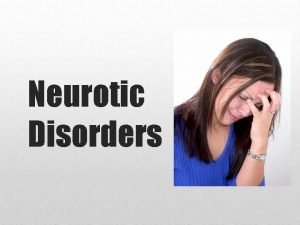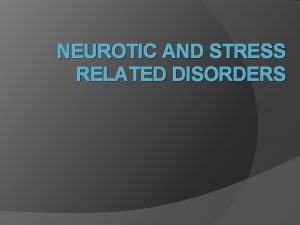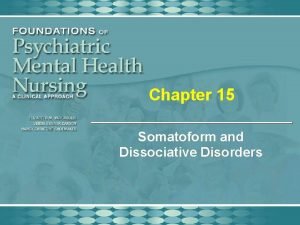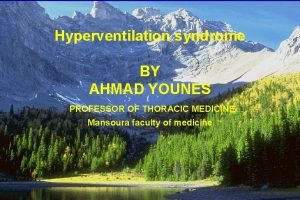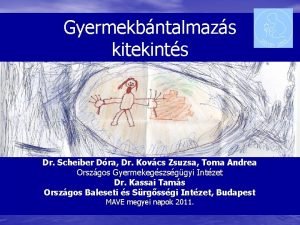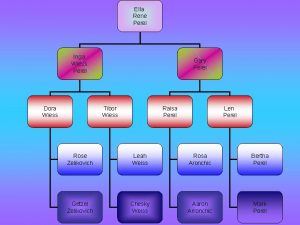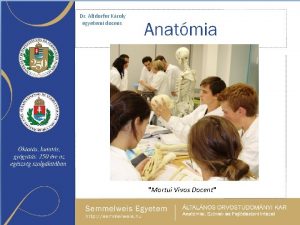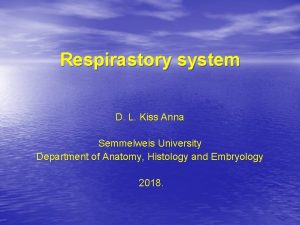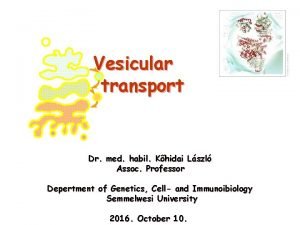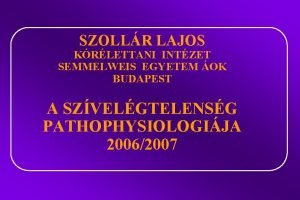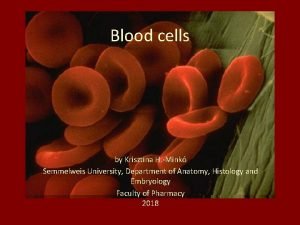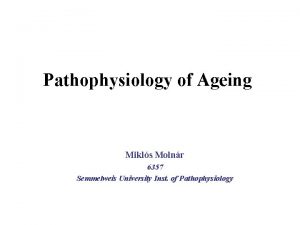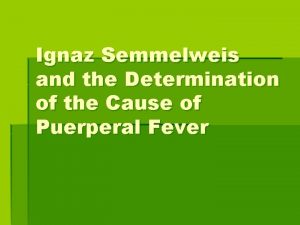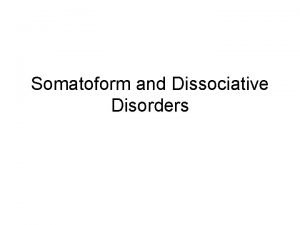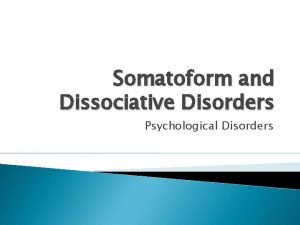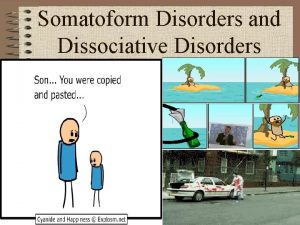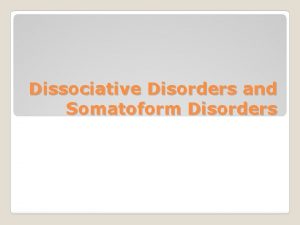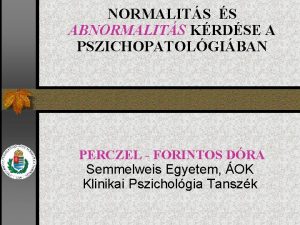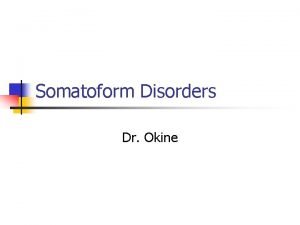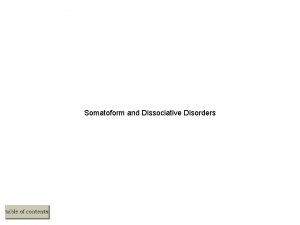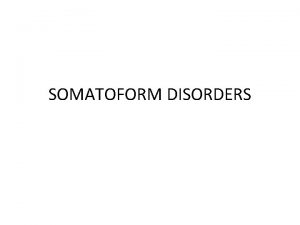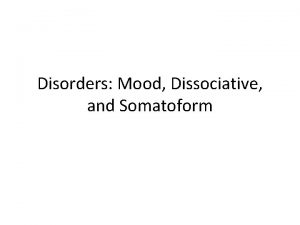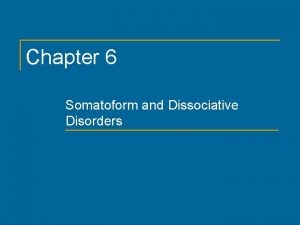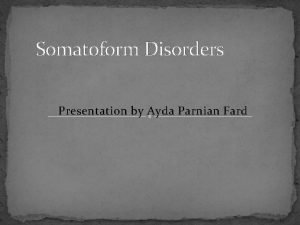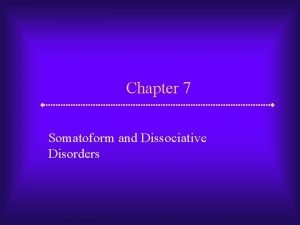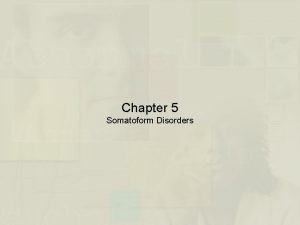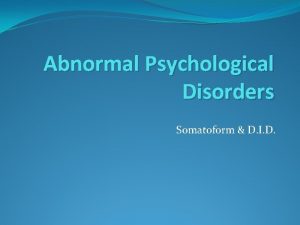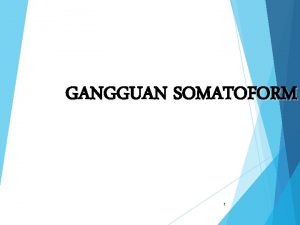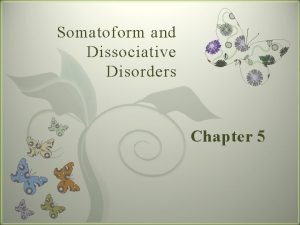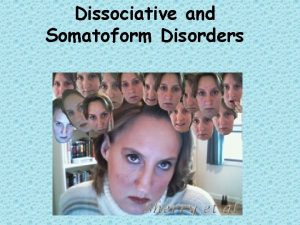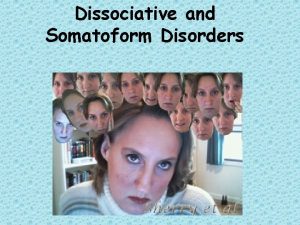Somatoform Disorders Dora Perczel Forintos Ph D Semmelweis














































- Slides: 46

Somatoform Disorders Dora Perczel Forintos, Ph. D. Semmelweis University Dep. of Clinical Psychology Psychiatry undergraduate course - 2013

Somatoform Disorders 1. SOMATIZATION DISORDER 2. CONVERSION DISORDER 3. HYPOCHONDRIASIS 4. PAIN DISORDER 5. BODY DYSMORPHIC DISORDER

DEFINITION Physical symptoms that seem as if they were part of a general medical condition, however no general medical condition, other mental disorder, or substance is present.

Characteristics of Somatoform Disorders - closely related to anxiety disorders - somatic symptoms without organic basis - the person has poor insight - does not recognize that concerns are excessive, unreasonable - reassurance is not helpful.

1. Somatizaton Disorder: clinical description 1. Long list of somatic complaints with n medical basis. 2. Patients preoccupied with their syptoms despite proper medical evaluation

CLINICAL DESCRIPTION 3. Focus on symptom itself and not what the symptom means. Life itself may revolve around the symptom, as well as relationships.

PREVALENCE 0. 7% - on a continuum of impairment because of disorder. 10 x higher incidence in females Lower socioeconomical status

REINFORCING, CONTRIBUTING FACTORS a. Social environment – illness status is socially approved and accompanied by more attention and less demand b. Past background of disproportionate incidence of illness or injury in childhood.

ILLUSTRATIVE CASE 1. A 36 -year-old divorced woman who worked as a salesclerk entered the hospital emergency room at 2. 00 AM complaining loudly that something was wrong with her stomach. She was tearful and agitated, with arms held tightly across her abdomen. She stated that shortly after her evening meal she began to feel nausea and „bloated” and that she vomited some undigested food. Within minutes of vomiting she began to feel a dull pain in her periumbilical area that gradually became sharper and spread throughout her entire abdome; when the pain became „unbearable, ” she decided to come to the emergency room. As the patient calmed down and became more comfortable, she stated that she had many similar episodes of abdominal discomfort over the past 15 years but that no doctor had been able to determine the cause. 9

At the age of 18 she had severe salpingitis requiring removel of the left oviduct, and 2 years later, because of persistent abdominal pain, the right ovary was removed. When she was 22, she underwent cholecystectomy, and over the next 10 years she had 3 abdominal surgical procedures to correct „adhesions” causing abdominal pain. She said, physicians had told her that she had ”an ulcer” or „colitis, ” but despite a variety of medical treatments her symptoms had persisted. On further questioning, she also admitted to sporadic episodes of dizziness, chest pain that awakened her from sleep, chronic dysuria, occasional urinary retention requiring catheterization, and chronic low back pain. She commnted that „only someone with a poor constitution could be sick for this long. She admitted taking diazepam (10 mg) 4 times a day for „nerves, ” phenobarbital (30 mg) 4 times a day for her gastric symptoms, and „some pain pills whener I need them’ – each medication prescribed by a different physician. Except for voluntary guarding on palpation of the abdomen and the old abdominal surgical scars, physical examination was normal. 10

DSM-III-R DIAGNOSTIC CRITERIA FOR SOMATIZATION DISORDER A. A history of many physical complaints or a belief that one is sickly, beginning before the age of 30 and persisting for several years. B. At least 13 symptoms from the list below. (1) No organic pathology or pathophysiologic mechanism (eg, a physical disorder or the effects of an injury, medication, drugs, or alcohol) to account for the symptom or, when there is related organic pathology, the complaint or resulting social or occupational impairment is grossly in excess of what would be expected from the physical findings.

(2) Has not occured only during a panic attack. (3) Has caused the person to take medicine (other than over-the-counter pain medication), see a doctor, or alter life-style. Gastrointestinal symptoms: (1) vomiting (other than during pregnancy); (2) abdominal pain (other than when menstruating); (3) nausea (other than motion sickness); (4) bloating (gassy); (5) diarrhea; (6) intolerance of (gets sick on) several different foods. Pain symptoms: (7) pain in extremities; (8) back pain; (9) joint pain; (10) pain during urination; (11) other pain (excluding headaches). Cardiopulmonary symptoms: (12) shortness of breath when not exerting oneself; (13) palpitations; (14) chest pain; (15) dizziness.

Conversion or pseudoneurologic symptoms: (16) amnesia; (17) difficulty swallowing; (18) loss of voice; (19) deafness; (20) double vision; (21) blurred vision; (22) blindness; (23) fainting or loss of consciousness; (24) seizure or convulsion; (25) trouble walking; (26) paralysis or muscle weakness; (27) urinary retention or difficulty urinating. Sexual symptoms for the major part of the person’s life after opportunities for sexual activity: (28) burning sensation in sexual organs or rectum (other than during inter-course); (29) sexual indifference; (30) pain during intercourse; (31) impotence. Female reproductive symptoms judged by the person to occur more frequently or severely than in most women: (32) painful menstruation; (33) irregular menstrual periods; (34) excessive menstrual bleeding; (35) vomiting throughout pregnancy.

TREATMENT Stress management Reduction of reinforcing or supporting consequences Group therapy Cognitive behaviour (CBT) therapy

2. CONVERSION DISORDER Loss or alteration of physical functioning that suggests physical disorder but are related to psychological conflict or need. No voluntary control over symptoms Symtoms suggest neurological disease of the sensory or motor system: paresis, paralysis, aphonia, seizures, blindness, anesthesia

2. CONVERSION DISORDER Generally refers to physical malfunctioning, such as a paralysis, blindness, or difficulty speaking (aphonia), without any physical or organic pathology what would account for the malfunction. Anxiety supposed to come from problems /conflicts / life-stresses which are not conscious and "converted" into physical symptoms.

KEY FEATURES - Symptom often has symbolic meaning: vomiting, globus in throat, breathlessness

PREVALENCE -1% - 30%; primarily in women, in adolescence and thereafter, tough frequently seen in men enduring great stress and trauma, such as combat soldiers. - higher incidence in less educated, lower socioeconomic groups where knowledge about disease and medical illness is not as well developed. - Other family member's experience with illness (patients tend to „learn" symptoms).

ILLUSTRATIVE CASE 2. A 21 -year-old college student telephoned her physician and, later the same day, appeared (with her mother) at his office with the complaint that she had awakened from sleep 2 days earlier with total numbness and paralysis in both legs. She had no idea what was the matter but that she was incapable of caring for herself and had summoned her mother from another state to come and take care of her. The patient had a history of good physical and mental health except for an episode of bilateral hip pain at age 14 that had resolved spontaneously. For the past 2 years she had shared an apartment with her boyfriend, but after a prolonged series of arguments he had moved out on the day preceding the onset of her symptoms. 19

On examination, the patient appeared slightly tense but in no acute distress. She stated that she knew she should seek medical help for the paralysis, but her main worry was how she was going to „support” herself without her boyfriend’s contributions to the household expenses. She was completely unable to move either leg, and there was total anesthesia and lack of response to painful stimuli (pinprick) in both legs up to the inginal ligament bilaterally, where sensation abruptly resumed. All deep tendon reflexes and both plantar reflexes were normal, as was the rest of the physical examination. 20

CRITERIA FOR CONVERSION DISORDER 1. One or more symptoms or deficits affecting voluntary motor or sensory function that suggest a neurological or general medical condition. 2. Psychological factors are judged to be associated with the symptom or deficit because the initiation or exacerbation of the symptom or deficit is preceded by conflicts or other stressors.

CRITERIA FOR CONVERSION DISORDER 3. The symptom or deficit is not intentionally produced (as in factitious disorder or malingering). 4. The symptom or deficit cannot, after appropriate investigation, be fully explained by a general medical condition, or by the direct effects of a substance, or as a culturally sanctioned behaviour or experience.

CRITERIA FOR CONVERSION DISORDER 5. The symptom or deficit causes clinically significant distress or impairment in social, occupational, or other important areas of functioning or warrants medical evaluation. 6. The symptom or deficit is not limited to pain or sexual dysfunction, does not occur exclusively during the course of somatization disorder, and is not better accounted for by another mental disorder.

Irritable bowel syndrome (IBS) TRIGGER SITUATION: WHENEVER HE HAS TO LEAVE THE HOUSE AUTOMATIC THOUGHTS: (perceived danger) Body symptoms Sweating Increased gastric mobility diarrhea „I will not survive. ” „I will be ashamed. ” „People will laugh at me. ” Emotional reactions: fear, frightened Behaviour starving, checking early get up and using the toilet before leaving 24

CONVERSION DISORDER TREATMENT Attention to traumatic or stressful life event, if present Reduction of any reinforcing or supportive consequences of the symptom Hypnosis/self-hypnosis Cognitive behaviour therapy

3. HYPOCHONDRIASIS clinical description Possibility of having a serious disease Possibility is so real that even medical reassurance will not help Key feature: concern or preoccupation with physical symptoms Core feature: disease conviction Prevalence: 4% - 9%, higher in elderly. Ration men to women 50/50

Reinforcing Factors a. Social environment b. Fear of having illness increases anxiety, which increases symptom perception, etc. - vicious cycle c. Enhanced perceptual sensitivity to illness cues, causing them to interpret as dangerous and threatening any stimuli d. Disproportionate incidences of illness in childhood

HYPOCHONDRIASIS – DSM-IV. criteria 1. Preoccupation with fears of having, or ideas that one has, a serious disease based on the person's misinterpretations of bodily ymptoms. 2. The preoccupation persists despite appropriate medical evaluation and reassurance.

DIAGNOSTIC CRITERIA FOR HYPOCHONDRIASIS 3. The belief (Criterion 1) is not of delusional intensity and is not restricted to a circumscribed concern about body appearance. 4. The preoccupation causes clinically significant distress or impairment in social, occupational, or other important areas of functioning.

DIAGNOSTIC CRITERIA FOR HYPOCHONDRIASIS 5. The duration of the disturbance is at least 6 months. 6. The preoccupation is not better accounted for by Generalised Anxiety Disorder, Obsessive-Compulsive Disorder, Panic Disorder, a Major Depressive Episode, Separation Anxiety, or another Somatoform Disorder

CONCEPTUALIZATION in HYPOCHONDRIASIS (Salkovskis, 1996) TRIGGER SITUATION: listening to a radio program about disorders AUTOMATIC NEGATIVE THOUGHTS: „It will happen to me, too. ” „My liver is not healthy. ” „I will die” „I suffer from an uncurable disease. ” MOOD: anxiety, fear 31

AUTOMATIC NEGATIVE THOUGHTS: „It will happen to me, too. ” „My liver is not healthy. ” „I will die” „I suffer from an uncurable disease. ” MOOD: anxiety, fear BEHAVIOUR: checking, pushing, reassurrance seeking SOMATIC SYMPTOMS: aches and pains, stubbly feeling in the liver, cardiac chest pain

EARLY EXPERIENCES: parents’ divorce, ignorance by stepfather mother’s diseases, hospitalization stepfather’s death due to livercancer CORE BELIEFS: „I am so little and unprotected. ” „I am exposed to diseases. ” DYSFUNCTIONAL ATTITUDES: „If I am not careful enough, I can develop an illness. ” „If I pay attention to my body canges, I can prevent illnessnes. ” „Pain is always a sign of a serious illness. ”

CRITICAL / KEY EXPERIENCES: 33 yr. : daughter is born with Down-syndrome, 34 yr. : death of girlfriend due to liver insufficiency TRIGGER SITUATION: e. g. listening to a radio program about disorders o NEGATIVE THOUGHTS o LOW MOOD o SAFETY SEEKING BEHAVIOURS o SOMATIC SYMPTOMS

Potentially threatening stimuli (situations, sensations, thoughts) (Selective attention) Threat appraisal Probability x Awfulness Coping + Rescue (Prevent Disconfirmation, Increase Symptoms) (Arousal) Safety-seeking behaviours Psychological and (avoidance, escape, within-situation biological changes behaviours, neutralizing, checking, reassurance seeking) Salkovskis (1996): Cognitive model of Hypochondriasis

HYPOCHONDRIASIS TREATMENT 1. Focus on illness preoccupaiton 2. Focus directly on the anxiety 3. Cognitive behaviour therapy 4. Psychopharmacotherapy 5. Relaxation and guuided imagery

4. PAIN DISORDERS diagnostic criteria 1. Pain in one or more anatomical sites is the predominant focus of the clinical presentation and is of sufficient severity to warrant clinical attention. 2. The pain causes clinically significant distress or impairment in social, occupational, or other important areas of functioning.

DIAGNOSTIC CRITERIA 3. Psychological factors are judged to have an important role in the onset, severity, exacerbation, or maintenance of the pain. 4. The symptom or deficit is not intentionally produced or feigned (as in factitious disorder or malingering).

DIAGNOSTIC CRITERIA 5. The pain is not better accounted for by a mood, anxiety, or psychotic disorder and does not meet criteria for dyspareunia. ACUTE: less 6 mo. CHRONIC: 6 mo. or more

1. Very difficult to assess if pain is primarily psychological or if causes are primarily physical. 2. Important feature: pain is real whether psychological or physical.

41

PAIN DISORDER TREATMENT l. Multidisciplinary clinic 2. CBT 3. Pharmacotherapy 4. Biofeedback 5. Group and individual therapy

5. BODY DYSMORPHIC CLINICAL DESCRIPTION "Imagined ugliness" and "mirror fixation" either phobic avoidance or frequent checks to see if changes have occurred Usually accompanied by suicidal ideation, and suicide attempts

REINFORCERS / CONTRIBUTORS a. societal beauty values b. cultural standards / desirability factor c. family/partners values

CRITERIA FOR BODY DYSMORPHIC DISORDER I. Preoccupation with an imagined defect in appearance. If a slight physical anomaly is present, the person's concern is markedly excessive 2. The preoccupation causes significant distress or impairment in social, occupational, or other important areas of functioning. 3. The preoccupation is not better accounted for by another mental disorder (e. g. dissatisfaction with body shape and size in anorexia nervosa)

BODY DYSMORPHIC CLINICAL DESCRIPTION Related to anxiety OCD: co-occurs obsessive-compulsive disorders Prevalence greater than thought. Up to 70% of college students had some degree of dissatisfaction with their bodies slightly more females in Western World (62% males noted in Japan) Treatment: CBT, pharmacotherapy
 Neurosis disorder
Neurosis disorder Somatic symptom disorder
Somatic symptom disorder Neurotic stress-related and somatoform disorders
Neurotic stress-related and somatoform disorders Somatoform disorders
Somatoform disorders Perczel adél
Perczel adél Gangguan somatoform
Gangguan somatoform Hyperventialation
Hyperventialation Epidemiologi gangguan somatoform
Epidemiologi gangguan somatoform Somatoform disorder
Somatoform disorder Nagy dóra adriána
Nagy dóra adriána Dora ruiz
Dora ruiz Dora mali
Dora mali Apipa ip
Apipa ip Dora la exploradora
Dora la exploradora Tikvicki dóra
Tikvicki dóra Lisa dora sonet
Lisa dora sonet Dora dymant
Dora dymant Dora luz llanes herrera
Dora luz llanes herrera Dora chico
Dora chico Scheiber dóra
Scheiber dóra In dora
In dora Dora perelli
Dora perelli Emily bronte remembrance
Emily bronte remembrance Agjus jobbörse
Agjus jobbörse Dora pejačević
Dora pejačević Frane bitunjac
Frane bitunjac Claude cahu
Claude cahu Interdictum de arboribus caedendis
Interdictum de arboribus caedendis Itc semmelweis seka
Itc semmelweis seka Semmelweis
Semmelweis Semmelweis
Semmelweis Hs iv
Hs iv Semmelweis university faculty of medicine
Semmelweis university faculty of medicine Nasal vestibule
Nasal vestibule Neptun semmelweis
Neptun semmelweis Alberts
Alberts Garatívek
Garatívek Pathophysiologie semmelweis
Pathophysiologie semmelweis Different between plasma and serum
Different between plasma and serum Konservierende zahnheilkunde semmelweis
Konservierende zahnheilkunde semmelweis Semmelweis egyetem konzerváló fogászati klinika budapest
Semmelweis egyetem konzerváló fogászati klinika budapest Molnr
Molnr Absorbtion
Absorbtion Ignas semmelweis
Ignas semmelweis Semmelweis
Semmelweis Agnes csaki semmelweis
Agnes csaki semmelweis Semmelweis reflex
Semmelweis reflex
